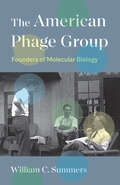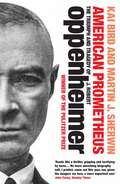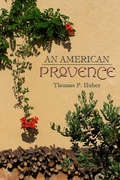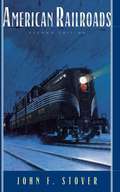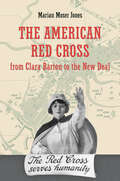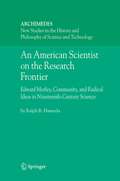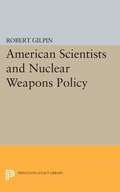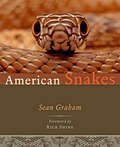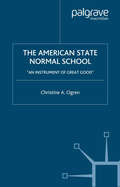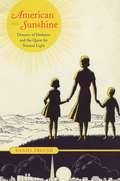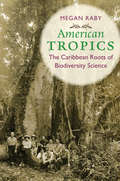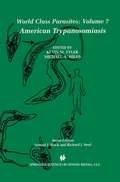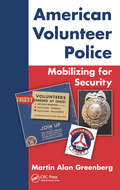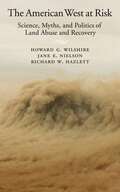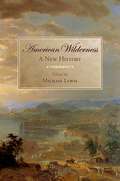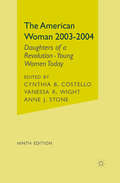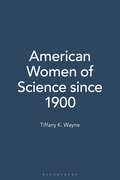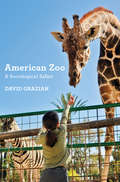- Table View
- List View
The American Phage Group: Founders of Molecular Biology
by William C. SummersA fascinating historical account of the American Phage Group and how its new research framework became the foundation for molecular biology This book is the first critical and analytical study of the American Phage Group—a small group of scientists who gathered around Max Delbrück, Salvador Luria, and Alfred Hershey between 1940 and 1960—and how this novel research program became the foundation of the field of molecular biology. These three young, charismatic, and iconoclastic scientists were convinced of the importance of bacterial viruses (bacteriophages) to the study of the gene and of heredity in general. Based on substantial archival research, numerous participant interviews collected over the past thirty years, and an intimate knowledge of the relevant scientific literature in the field, William C. Summers has written a fascinating new history of the American Phage Group. Rather than a linear narrative of progress by past heroes, this book emphasizes the diversity and historical contingencies in the group’s development.
American Prometheus: The Triumph and Tragedy of J. Robert Oppenheimer
by Kai Bird Martin J. Sherwin***SOON TO BE A MAJOR HOLLYWOOD FILM DIRECTED BY CHRISTOPHER NOLAN***WINNER OF THE PULITZER PRIZE FOR NONFICTION 'Reads like a thriller, gripping and terrifying' Sunday TimesPhysicist and polymath, as familiar with Hindu scriptures as he was with quantum mechanics, J. Robert Oppenheimer - director of the Manhattan Project that developed the atomic bomb - was the most famous scientist of his generation. In their meticulous and riveting biography, Kai Bird and Martin J. Sherwin reveal a brilliant, ambitious, complex and flawed man, profoundly involved with some of the momentous events of the twentieth century.
An American Provence
by Thomas P. Huber"I have talked about luscious wines and succulent fruit and exquisite dinners. But there may be no more evocative experience of the two valleys than the smell of new-mown hay in the fields at dusk. If a person were to close their eyes, they could not tell if they were in Provence or the North Fork Valley. That sweet, earthy odor is part of the beauty of these places." -From An American Provence In this poetic personal narrative, Thomas P. Huber reflects on two seemingly unrelated places-the North Fork Valley in western Colorado and the Coulon River Valley in Provence, France-and finds a shared landscape and sense of place. What began as a simple comparison of two like places in distant locations turned into a more complex, interesting, and personal task. Much is similar-the light, the valleys, the climate, the agriculture. And much is less so-the history, the geology, the physical makeup of villages. Using a geographer's eye and passion for the land and people, Huber examines the regions' similarities and differences to explore the common emotional impact of each region. Part intimate travelogue and part case study of geography in the real world, An American Provence illuminates the importance sense of place plays in who we are.
American Railroads (The Chicago History of American Civilization)
by John F. StoverFew scenes capture the American experience so eloquently as that of a lonely train chugging across the vastness of the Great Plains, or snaking through tortuous high mountain passes. Although this vision was eclipsed for a time by the rise of air travel and trucking, railroads have enjoyed a rebirth in recent years as profitable freight carriers. A fascinating account of the rise, decline, and rebirth of railroads in the United States, John F. Stover's American Railroads traces their history from the first lines that helped eastern seaports capture western markets to today's newly revitalized industry. Stover describes the growth of the railroads' monopoly, with the consequent need for state and federal regulations; relates the vital part played by the railroads during the Civil War and the two World Wars; and charts the railroads' decline due to the advent of air travel and trucking during the 1950s. In two new chapters, Stover recounts the remarkable recovery of the railroads, along with other pivotal events of the industry's recent history. During the 1960s declining passenger traffic and excessive federal regulation led to the federally-financed creation of Amtrak to revive passenger service and Conrail to provide freight service on bankrupt northeastern railroads. The real savior for the railroads, though, proved to be the Staggers Rail Act of 1980, which brought prosperity to rail freight carriers by substantially deregulating the industry. By 1995, renewed railroad freight traffic had reached nearly twice its former peak in 1944. Bringing both a seasoned eye and new insights to bear on one of the most American of industries, Stover has produced the definitive history of railroads in the United States.
The American Red Cross from Clara Barton to the New Deal
by Marian Moser JonesIn dark skirts and bloodied boots, Clara Barton fearlessly ventured on to Civil War battlefields to tend to wounded soldiers. She later worked with civilians in Europe during the Franco-Prussian War, lobbied legislators to ratify the Geneva conventions, and founded and ran the American Red Cross. The American Red Cross from Clara Barton to the New Deal tells the story of the charitable organization from its start in 1881, through its humanitarian aid during wars, natural disasters, and the Depression, to its relief efforts of the 1930s.Marian Moser Jones illustrates the tension between the organization's founding principles of humanity and neutrality and the political, economic, and moral pressures that sometimes caused it to favor one group at the expense of another. This expansive book narrates the stories of: • U.S. natural disasters such as the Jacksonville yellow fever epidemic of 1888, the Sea Islands hurricane of 1893, and the 1906 San Francisco earthquake• crises abroad, including the 1892 Russian famine and the Armenian massacres of 1895–96• efforts to help civilians affected by the civil war in Cuba• power struggles within the American Red Cross leadership and subsequent alliances with the American government• the organization's expansion during World War I• race riots in East St. Louis, Chicago, and Tulsa between 1917 and 1921• help for African American and white Southerners after the Mississippi flood of 1927• relief projects during the Dust Bowl and after the New DealAn epilogue relates the history of the American Red Cross since the beginning of World War II and illuminates the organization's current practices as well as its international reputation.
An American Scientist on the Research Frontier: Edward Morley, Community, and Radical Ideas in Nineteenth-Century Science (Archimedes #13)
by Ralph R. HamerlaAn American Scientist on the Research Frontier is the first scholarly study of the nineteenth-century American scientist Edward Williams Morley. In part, it is the long-overdue story of a man who lent his name to the Michelson and Morley Ether-Drift Experiment, and who conclusively established the atomic weight of oxygen. It is also the untold story of science in provincial America: what Hamerla presents as science on the "American research frontier". This important examination of Morley’s struggle for personal and professional legitimacy extends and transforms our understanding of science during a foundational period, and leads to a number of unique conclusions that are vital to the literature and historiography of science. By revealing important aspects of the scientific culture of the American heartland, An American Scientist on the Research Frontier deepens our understanding of an individual scientist and of American science more broadly. In so doing, Hamerla changes the way we approach and understand the creation of scientific knowledge, scientific communities, and the history of science itself.
American Scientists and Nuclear Weapons Policy
by Robert GilpinAs this study traces the history of the dramatic intra-scientific conflict over nuclear weapons which has developed since World War II, it analyzes the politically relevant ideas, attitudes, and behavior of those scientists who have been influential in the formulation of American policy toward nuclear weapons. The author contends that the emergence of the scientist into the mainstream of American political life is one of the great events of our history. As he assays the situation, he emphasizes the growing need for effective measures for integrating scientist-advisers into national policy-making processes. This well documented book will be of lasting value to both scientists and public administrators, and it will be of vital interest to all concerned with current problems of the nuclear era.Originally published in 1962.The Princeton Legacy Library uses the latest print-on-demand technology to again make available previously out-of-print books from the distinguished backlist of Princeton University Press. These editions preserve the original texts of these important books while presenting them in durable paperback and hardcover editions. The goal of the Princeton Legacy Library is to vastly increase access to the rich scholarly heritage found in the thousands of books published by Princeton University Press since its founding in 1905.
American Snakes
by Sean P. Graham125 million years ago on the floodplains of North America, a burrowing lizard started down the long evolutionary path of shedding its limbs. The 60-plus species of snakes found in Sean P. Graham's American Snakes have this ancestral journey to thank for their ubiquity, diversity, and beauty. Although many people fear them, snakes are as much a part of America's rich natural heritage as redwoods, bald eagles, and grizzly bears. Found from the vast Okefenokee Swamp to high alpine meadows, from hardwood canopies to the burning bottom of the Grand Canyon, these ultimate vertebrates are ecologically pivotal predators and quintessential survivors.In this revelatory and engaging meditation on American snakes, Graham, a respected herpetologist and gifted writer, ;€¢ explains the everyday lives of American snakes, from their daily routines and seasonal cycles to their love lives, hunting tactics, and defensive repertoires;€¢ debunks harmful myths about snakes and explores their relationship with humans;€¢ highlights the contribution of snakes to the American wilderness;€¢ tells tales of "snake people";¢;‚¬;€?important snake biologists with inspiring careersNeither a typical field guide nor an exhaustive reference, American Snakes is instead a fascinating study of the suborder Serpentes. Brimming with intriguing and unusual stories;¢;‚¬;€?of hognose snakes that roll over and play dead, blindsnakes with tiny vestigial lungs, rainbow-hued dipsadines, and wave-surfing sea-snakes;¢;‚¬;€?the text is interspersed with scores of gorgeous full-color images of snakes, from the scary to the sublime. This proud celebration of a diverse American wildlife group will make every reader, no matter how skeptical, into a genuine snake lover.
American Snakes
by Sean P. Graham125 million years ago on the floodplains of North America, a burrowing lizard started down the long evolutionary path of shedding its limbs. The 60-plus species of snakes found in Sean P. Graham's American Snakes have this ancestral journey to thank for their ubiquity, diversity, and beauty. Although many people fear them, snakes are as much a part of America's rich natural heritage as redwoods, bald eagles, and grizzly bears. Found from the vast Okefenokee Swamp to high alpine meadows, from hardwood canopies to the burning bottom of the Grand Canyon, these ultimate vertebrates are ecologically pivotal predators and quintessential survivors.In this revelatory and engaging meditation on American snakes, Graham, a respected herpetologist and gifted writer, ;€¢ explains the everyday lives of American snakes, from their daily routines and seasonal cycles to their love lives, hunting tactics, and defensive repertoires;€¢ debunks harmful myths about snakes and explores their relationship with humans;€¢ highlights the contribution of snakes to the American wilderness;€¢ tells tales of "snake people";¢;‚¬;€?important snake biologists with inspiring careersNeither a typical field guide nor an exhaustive reference, American Snakes is instead a fascinating study of the suborder Serpentes. Brimming with intriguing and unusual stories;¢;‚¬;€?of hognose snakes that roll over and play dead, blindsnakes with tiny vestigial lungs, rainbow-hued dipsadines, and wave-surfing sea-snakes;¢;‚¬;€?the text is interspersed with scores of gorgeous full-color images of snakes, from the scary to the sublime. This proud celebration of a diverse American wildlife group will make every reader, no matter how skeptical, into a genuine snake lover.
The American State Normal School: An Instrument of Great Good
by C. OgrenThe American State Normal School is the first comprehensive history of the state normal schools in the United States. Although nearly two-hundred state colleges and regional universities throughout the U.S. began as 'normal' schools, the institutions themselves have buried their history, and scholars have largely overlooked them. As these institutions later became state colleges and/or regional universities, they distanced themselves from the low status of elementary-literally erasing physical evidence of their normal-school past. In doing so, they buried the rich history of generations of students for whom attending normal school was an enriching, and sometimes life-changing experience. Focusing on these students, the first wave of 'non-traditional' students in higher education, The American State Normal School is a much-needed re-examination of the state normal school.This book was subject of an annual History of Education Society panel for best new books in the field.
American Sunshine: Diseases of Darkness and the Quest for Natural Light
by Daniel FreundIn the second half of the nineteenth century, American cities began to go dark. Hulking new buildings overspread blocks, pollution obscured the skies, and glass and smog screened out the health-giving rays of the sun. Doctors fed anxities about these new conditions with claims about a rising tide of the "diseases of darkness," especially rickets and tuberculosis. In American Sunshine, Daniel Freund tracks the obsession with sunlight from those bleak days into the twentieth century. Before long, social reformers, medical professionals, scientists, and a growing nudist movement proffered remedies for America’s new dark age. Architects, city planners, and politicians made access to sunlight central to public housing and public health. and entrepreneurs, dairymen, and tourism boosters transformed the pursuit of sunlight and its effects into a commodity. Within this historical context, Freund sheds light on important questions about the commodification of health and nature and makes an original contribution to the histories of cities, consumerism, the environment, and medicine.
American Sunshine: Diseases of Darkness and the Quest for Natural Light
by Daniel FreundIn the second half of the nineteenth century, American cities began to go dark. Hulking new buildings overspread blocks, pollution obscured the skies, and glass and smog screened out the health-giving rays of the sun. Doctors fed anxities about these new conditions with claims about a rising tide of the "diseases of darkness," especially rickets and tuberculosis. In American Sunshine, Daniel Freund tracks the obsession with sunlight from those bleak days into the twentieth century. Before long, social reformers, medical professionals, scientists, and a growing nudist movement proffered remedies for America’s new dark age. Architects, city planners, and politicians made access to sunlight central to public housing and public health. and entrepreneurs, dairymen, and tourism boosters transformed the pursuit of sunlight and its effects into a commodity. Within this historical context, Freund sheds light on important questions about the commodification of health and nature and makes an original contribution to the histories of cities, consumerism, the environment, and medicine.
American Sunshine: Diseases of Darkness and the Quest for Natural Light
by Daniel FreundIn the second half of the nineteenth century, American cities began to go dark. Hulking new buildings overspread blocks, pollution obscured the skies, and glass and smog screened out the health-giving rays of the sun. Doctors fed anxities about these new conditions with claims about a rising tide of the "diseases of darkness," especially rickets and tuberculosis. In American Sunshine, Daniel Freund tracks the obsession with sunlight from those bleak days into the twentieth century. Before long, social reformers, medical professionals, scientists, and a growing nudist movement proffered remedies for America’s new dark age. Architects, city planners, and politicians made access to sunlight central to public housing and public health. and entrepreneurs, dairymen, and tourism boosters transformed the pursuit of sunlight and its effects into a commodity. Within this historical context, Freund sheds light on important questions about the commodification of health and nature and makes an original contribution to the histories of cities, consumerism, the environment, and medicine.
American Sunshine: Diseases of Darkness and the Quest for Natural Light
by Daniel FreundIn the second half of the nineteenth century, American cities began to go dark. Hulking new buildings overspread blocks, pollution obscured the skies, and glass and smog screened out the health-giving rays of the sun. Doctors fed anxities about these new conditions with claims about a rising tide of the "diseases of darkness," especially rickets and tuberculosis. In American Sunshine, Daniel Freund tracks the obsession with sunlight from those bleak days into the twentieth century. Before long, social reformers, medical professionals, scientists, and a growing nudist movement proffered remedies for America’s new dark age. Architects, city planners, and politicians made access to sunlight central to public housing and public health. and entrepreneurs, dairymen, and tourism boosters transformed the pursuit of sunlight and its effects into a commodity. Within this historical context, Freund sheds light on important questions about the commodification of health and nature and makes an original contribution to the histories of cities, consumerism, the environment, and medicine.
American Tropics: The Caribbean Roots of Biodiversity Science (Flows, Migrations, and Exchanges)
by Megan RabyBiodiversity has been a key concept in international conservation since the 1980s, yet historians have paid little attention to its origins. Uncovering its roots in tropical fieldwork and the southward expansion of U.S. empire at the turn of the twentieth century, Megan Raby details how ecologists took advantage of growing U.S. landholdings in the circum-Caribbean by establishing permanent field stations for long-term, basic tropical research. From these outposts of U.S. science, a growing community of American "tropical biologists" developed both the key scientific concepts and the values embedded in the modern discourse of biodiversity.Considering U.S. biological fieldwork from the era of the Spanish-American War through the anticolonial movements of the 1960s and 1970s, this study combines the history of science, environmental history, and the history of U.S.–Caribbean and Latin American relations. In doing so, Raby sheds new light on the origins of contemporary scientific and environmentalist thought and brings to the forefront a surprisingly neglected history of twentieth-century U.S. science and empire.
American Trypanosomiasis (World Class Parasites #7)
by Kevin M. Tyler Michael A. MilesAmerican trypanosomiasis, or Chagas disease, is caused by the protozoan parasite, Trypanosoma cruzi. Sixteen to eighteen million people are currently infected with this organism, and 45,000 deaths are attributed to the disease each year. Infection with T. cruzi is life-long, and 10-30% of persons who harbor the parasite chronically develop cardiac and gastrointestinal problems associated with the parasitosis. Although major progress has been made in recent years in reducing vector-borne and transfusion-associated transmission of T. cruzi, the burden of disability and death in persons chronically infected with the organism continues to be enormous. Eight to ten million persons born in countries in which Chagas disease is endemic currently reside in the United States, and epidemiologic and census data suggest that 50,000-100,000 are chronically infected with T. cruzi. The presence of these infected persons poses a risk of transmission of the parasite in the USA through blood transfusion and organ transplantation and several such cases have now been documented. American Trypanosomiasis, volume seven of World Class Parasites is written for students of tropical medicine, parasitology and public health, for researchers and practitioners alike who wish to bring themselves abreast of the status quo with respect to this disease. It is intended to supplement formal textbooks, in order to broaden and illuminate current areas of scientific and public health concern. Uniquely for T. cruzi, this book addresses parasite, vector and host biology, the pathogenesis of Chagas disease and current and prospective therapeutics and control strategies in a single volume.
American Volunteer Police: Mobilizing for Security
by Martin Alan GreenbergToday, it is estimated there are over 200,000 volunteers in police work throughout the United States. Although the need for such volunteers has never been greater, there is a lack of published materials regarding the nature of volunteer police work and how qualified citizens may augment police services. American Volunteer Police: Mobilizing for Sec
The American West at Risk: Science, Myths, and Politics of Land Abuse and Recovery
by Richard W. Hazlett Howard G. Wilshire Jane E. NielsonThe American West at Risk summarizes the dominant human-generated environmental challenges in the 11 contiguous arid western United States - America's legendary, even mythical, frontier. When discovered by European explorers and later settlers, the west boasted rich soils, bountiful fisheries, immense, dense forests, sparkling streams, untapped ore deposits, and oil bonanzas. It now faces depletion of many of these resources, and potentially serious threats to its few "renewable" resources. The importance of this story is that preserving lands has a central role for protecting air and water quality, and water supplies--and all support a healthy living environment. The idea that all life on earth is connected in a great chain of being, and that all life is connected to the physical earth in many obvious and subtle ways, is not some new-age fad, it is scientifically demonstrable. An understanding of earth processes, and the significance of their biological connections, is critical in shaping societal values so that national land use policies will conserve the earth and avoid the worst impacts of natural processes. These connections inevitably lead science into the murkier realms of political controversy and bureaucratic stasis. Most of the chapters in The American West at Risk focus on a human land use or activity that depletes resources and degrades environmental integrity of this resource-rich, but tender and slow-to-heal, western U.S. The activities include forest clearing for many purposes; farming and grazing; mining for aggregate, metals, and other materials; energy extraction and use; military training and weapons manufacturing and testing; road and utility transmission corridors; recreation; urbanization; and disposing of the wastes generated by everything that we do. We focus on how our land-degrading activities are connected to natural earth processes, which act to accelerate and spread the damages we inflict on the land. Visit www.theamericanwestatrisk.com to learn more about the book and its authors.
The American West at Risk: Science, Myths, and Politics of Land Abuse and Recovery
by Howard G. Wilshire Jane E. Nielson Richard W. HazlettThe American West at Risk summarizes the dominant human-generated environmental challenges in the 11 contiguous arid western United States - America's legendary, even mythical, frontier. When discovered by European explorers and later settlers, the west boasted rich soils, bountiful fisheries, immense, dense forests, sparkling streams, untapped ore deposits, and oil bonanzas. It now faces depletion of many of these resources, and potentially serious threats to its few "renewable" resources. The importance of this story is that preserving lands has a central role for protecting air and water quality, and water supplies--and all support a healthy living environment. The idea that all life on earth is connected in a great chain of being, and that all life is connected to the physical earth in many obvious and subtle ways, is not some new-age fad, it is scientifically demonstrable. An understanding of earth processes, and the significance of their biological connections, is critical in shaping societal values so that national land use policies will conserve the earth and avoid the worst impacts of natural processes. These connections inevitably lead science into the murkier realms of political controversy and bureaucratic stasis. Most of the chapters in The American West at Risk focus on a human land use or activity that depletes resources and degrades environmental integrity of this resource-rich, but tender and slow-to-heal, western U.S. The activities include forest clearing for many purposes; farming and grazing; mining for aggregate, metals, and other materials; energy extraction and use; military training and weapons manufacturing and testing; road and utility transmission corridors; recreation; urbanization; and disposing of the wastes generated by everything that we do. We focus on how our land-degrading activities are connected to natural earth processes, which act to accelerate and spread the damages we inflict on the land. Visit www.theamericanwestatrisk.com to learn more about the book and its authors.
American Wilderness: A New History
by Michael LewisThis collected volume of original essays proposes to address the state of scholarship on the political, cultural, and intellectual history of Americans responses to wilderness from first contact to the present. While not bringing a synthetic narrative to wilderness, the volume will gather competing interpretations of wilderness in historical context.
American Wilderness: A New History
by Michael LewisThis collected volume of original essays proposes to address the state of scholarship on the political, cultural, and intellectual history of Americans responses to wilderness from first contact to the present. While not bringing a synthetic narrative to wilderness, the volume will gather competing interpretations of wilderness in historical context.
The American Woman, 2003-2004: Daughters of a Revolution: Young Women Today
by C. Costello V. Wight A. StoneThe American Woman is an established, widely respected series on the status of American women, prepared biannually by the Women's Research and Education Institute (WREI). The purpose of the series is to provide an important, convenient, and timely source of accessible and 'user-friendly' information on American women to the media, students and scholars, advocates for women's equity, and policymakers. Each edition of the series focuses on a particular theme, and the ninth edition will address young women between the ages of 25 and 35. Contributors - all experts in the field of women's issues - will explore the opportunities and challenges confronting the young women who are the daughters of the baby boomer generation. A focus on young women will bring into sharp relief how much has changed in the decades since 1960 and how much remains the same. A statistical portrait will accompany the volume, including user-friendly charts and graphs that provide readers with the hard numbers that underlie the trends shaping women's experiences.
American Women of Science since 1900 [2 volumes]: [2 volumes]
by Tiffany K. WayneA comprehensive examination of American women scientists across the sciences throughout the 20th century, providing a rich historical context for understanding their achievements and the way they changed the practice of science.Much more than a "Who's Who," this exhaustive two-volume encyclopedia examines the significant achievements of 20th century American women across the sciences in light of the historical and cultural factors that affected their education, employment, and research opportunities. With coverage that includes a number of scientists working today, the encyclopedia shows just how much the sciences have evolved as a professional option for women, from the dawn of the 20th century to the present.American Women of Science since 1900 focuses on 500 of the 20th century's most notable American women scientists—many overlooked, undervalued, or simply not well known. In addition, it offers individual features on 50 different scientific disciplines (Women in Astronomy, etc.), as well as essays on balancing career and family, girls and science education, and other sociocultural topics. Readers will encounter some extraordinary scientific minds at work, getting a sense of the obstacles they faced as the scientific community faced the questions of feminism and gender confronting the nation as a whole.
American Zoo: A Sociological Safari
by David GrazianOrangutans swing from Kevlar-lined fire hoses. Giraffes feast on celebratory birthday cakes topped with carrots instead of candles. Hi-tech dinosaur robots growl among steel trees, while owls watch animated cartoons on old television sets. In American Zoo, sociologist David Grazian takes us on a safari through the contemporary zoo, alive with its many contradictions and strange wonders.Trading in his tweed jacket for a zoo uniform and a pair of muddy work boots, Grazian introduces us to zookeepers and animal rights activists, parents and toddlers, and the other human primates that make up the zoo's social world. He shows that in a major shift away from their unfortunate pasts, American zoos today emphasize naturalistic exhibits teeming with lush and immersive landscapes, breeding programs for endangered animals, and enrichment activities for their captive creatures. In doing so, zoos blur the imaginary boundaries we regularly use to separate culture from nature, humans from animals, and civilization from the wild. At the same time, zoos manage a wilderness of competing priorities—animal care, education, scientific research, and recreation—all while attempting to serve as centers for conservation in the wake of the current environmental and climate-change crisis. The world of the zoo reflects how we project our own prejudices and desires onto the animal kingdom, and invest nature with meaning and sentiment.A revealing portrayal of comic animals, delighted children, and feisty zookeepers, American Zoo is a remarkable close-up exploration of a classic cultural attraction.
American Zoo: A Sociological Safari (PDF)
by David GrazianOrangutans swing from Kevlar-lined fire hoses. Giraffes feast on celebratory birthday cakes topped with carrots instead of candles. Hi-tech dinosaur robots growl among steel trees, while owls watch animated cartoons on old television sets. In American Zoo, sociologist David Grazian takes us on a safari through the contemporary zoo, alive with its many contradictions and strange wonders.Trading in his tweed jacket for a zoo uniform and a pair of muddy work boots, Grazian introduces us to zookeepers and animal rights activists, parents and toddlers, and the other human primates that make up the zoo's social world. He shows that in a major shift away from their unfortunate pasts, American zoos today emphasize naturalistic exhibits teeming with lush and immersive landscapes, breeding programs for endangered animals, and enrichment activities for their captive creatures. In doing so, zoos blur the imaginary boundaries we regularly use to separate culture from nature, humans from animals, and civilization from the wild. At the same time, zoos manage a wilderness of competing priorities—animal care, education, scientific research, and recreation—all while attempting to serve as centers for conservation in the wake of the current environmental and climate-change crisis. The world of the zoo reflects how we project our own prejudices and desires onto the animal kingdom, and invest nature with meaning and sentiment.A revealing portrayal of comic animals, delighted children, and feisty zookeepers, American Zoo is a remarkable close-up exploration of a classic cultural attraction.
